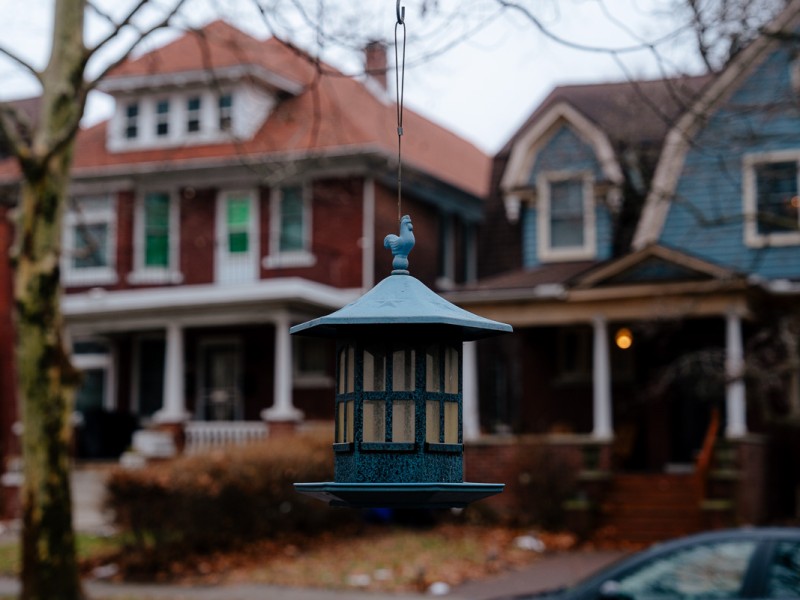Country Clubbing in the City
It’s where Great Gatsby elegance meets homey Palmer Woods style and grace. Take a peek inside the Detroit Golf Club, designed by two of the world’s leading architects.
On a sunny autumn day, at least 20 golf carts cue up with clubs on
the back, drinks on the console and happy faces savoring the last warm
days. Some players might be done for the season, but others will swing clubs through harsh
winds and foul weather, playing until the snow clogs the greens.
This scene is staged just beyond the lush foliage of Palmer Park, inside the guarded Hamilton gates at the exclusive Detroit Golf Club. It has two 18-hole golf courses, onsite PGA professionals and the elegant 77,000 square foot Albert Kahn-designed clubhouse for Detroit’s best golfers and their families. 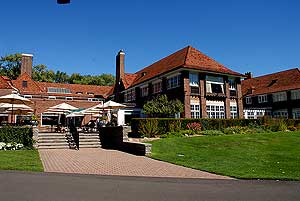 “This place is known as a players club, it was founded in 1899 by people who love golf and it continues to host the largest number of single-digit handicap golfers around southeast Michigan,” says Nancy Clavel Forte, recent Detroit Golf Club president and frequent member of the winner’s circle.
“This place is known as a players club, it was founded in 1899 by people who love golf and it continues to host the largest number of single-digit handicap golfers around southeast Michigan,” says Nancy Clavel Forte, recent Detroit Golf Club president and frequent member of the winner’s circle.
At least 30 members out of 750 boast handicaps under 2 points, a laudable goal, according to Clavel. She started with a handicap of 29 and whittled it down to 11 with zealous practice. She admits taking a backseat to PGA Champion Tiger Woods aficionado, the 14-year-old Joe Hooks of Commerce Township.
This summer Hooks won four out of seven tournaments for the Meijer Junior Player Tour in Michigan earning a 1.8 handicap against 215 other youths. Throughout the summer months he played two 18-hole rounds of golf daily while his parents ran grocery store in the city. As his talent soars adults come to him for swing techniques. Such diligence helped him earn a slot on the varsity golf team of the University of Detroit Jesuit High School as a freshman.
“This place feels like home,” Hooks says. The word, “home” with all its evocative feeling is echoed by any number of people at the Detroit Golf Club. Home is where the caddy stands waiting with a golf cart, and a bartender lines up shot glasses in the men’s locker room to pour your favorite drink. The Ferraris and Lamborghinis are as safe as Ford 500s in the guarded parking lot.
Happy destination
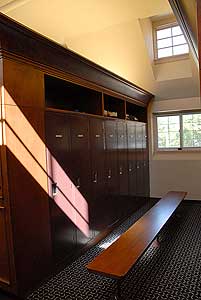 Truly a sense of order and tradition prevails inside the Detroit Golf Club regardless of what happens in the world at large. Members young and old agree to a lengthy set of rules and regulations. No jeans of any type or color are allowed, no spandex, no tube tops, halters or tank tops, no long baggy shorts with underwear hanging out. Khaki shorts and pants and golf shirts reign supreme and men wear jackets in the dining room.
Truly a sense of order and tradition prevails inside the Detroit Golf Club regardless of what happens in the world at large. Members young and old agree to a lengthy set of rules and regulations. No jeans of any type or color are allowed, no spandex, no tube tops, halters or tank tops, no long baggy shorts with underwear hanging out. Khaki shorts and pants and golf shirts reign supreme and men wear jackets in the dining room.
This “home” draws men and women members from as far as 50 miles away to practice their swing. They have paid as high as $35,000 a year to join and agree to spend at least $300 a month in prime season on meals and services. Business members enjoy taking clients for an outing where tee-times are guaranteed and the food is superb.
“This is an oasis from the everyday world,” Clavel says. Other members echo the same word and spirit, evoking a sense of “third place,” a happy destination between home and work.
Walter Elliott, the senior vice president of LaSalle Bank takes a long view, attempting to strengthen the bridge between the club and nearby neighborhoods through community outreach.
Growing up on Log Cabin, a street just south of the Detroit Golf Club, Elliott had big dreams. He served as the club’s first African-American president in 2000 and advocates often for caddy recruitment and scholarships.
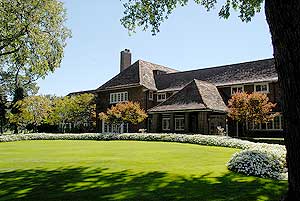 “As a kid I looked over the fence and thought the people living there had the most gigantic backyards in the world, never realizing it was a golf course back there,” Elliott says. “I dreamed of owning a piece of property and having all my friends over for football and baseball practice.” Instead he invites friends and family for a round of golf.
“As a kid I looked over the fence and thought the people living there had the most gigantic backyards in the world, never realizing it was a golf course back there,” Elliott says. “I dreamed of owning a piece of property and having all my friends over for football and baseball practice.” Instead he invites friends and family for a round of golf.
He rose to the inner management circle at Standard Federal/LaSalle and chose the Detroit Golf Club when given a perk to participate in a private club. “When I joined it was more of a gentleman’s club where executives from Ford and Chrysler’s old facilities in Highland Park often entertained suppliers,” Elliott says. “I’ve been proud of its transition to a family club with a kid’s pool, children’s golf league and caddie scholarship program.”
Collaborating with community
To visitors, the scene beyond the autumn glaze recalls a Great Gatsby elegance with an abundance of tuxedoed wait staff and fine gardens all around. Members arrive in formal attire for the President’s Ball and New Year’s Eve gala, while an ample veranda covers guests from the elements. A team of valets whisk the cars away.
Yet, exclusivity has morphed to a more collaborative approach that is the hallmark of Detroit’s better clubs. Detroit Golf Club officers invite neighboring homeowner associations, the University District and Golf Club residents to hold annual dinner dances inside its gates, merging those at the perimeter of the club with those occupying its inner world. Jim and Maria Thrower and Don Barden and Bella Marshall are club members and residents who often drive to dinner in golf carts. Club members refer to houses by the 12 tee or north green instead of housing architecture.
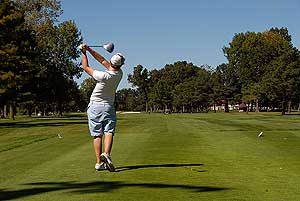 “The surrounding houses are beautiful, the people are doing a lot of renovation,” Elliott says, citing various examples. He expects some houses that have fallen on hard times will be torn down and even larger mansions built in place, reinforcing the atmosphere of elegance and style.
“The surrounding houses are beautiful, the people are doing a lot of renovation,” Elliott says, citing various examples. He expects some houses that have fallen on hard times will be torn down and even larger mansions built in place, reinforcing the atmosphere of elegance and style.
Detroit Golf Club dates itself back to 1899 when William R. Farrand (there’s a street named after him in Highland Park) invited several friends to golf on a 45-acre farmland at Woodward and McNichols on six holes. The early duffers rented a farm across the road as a locker and storage room on land at the north end of the street car line. With the Ford Highland Park building Model T’s just south on Woodward and new auto barons seeking athletic activity, the club leased 135 acres from Sen. Thomas W. Palmer for 10 years in the early 1900s.
In 1913 the Senator died, bequeathing a large portion of his land to the City of Detroit to make the public portion of Palmer Park and developing the wealthy neighborhood Palmer Woods to the north. The Detroit Golf Club purchased its leased property from the Palmer estate and additional land own by Horace Rackham for $350,000. Rackham remained a donor to the club for several decades, according to the club’s 100-year history book.
Commitment to vitality
The famed golf course architect Donald Ross was commissioned to design two 18-hole courses on the sprawling land. By 1916, the founders were ready to make a clubhouse and sought Albert Kahn, the architect who made Ford’s Highland Park factory a world class facility, to create its tile-roofed building that continues to serve weddings, society dinners, club meetings and more.
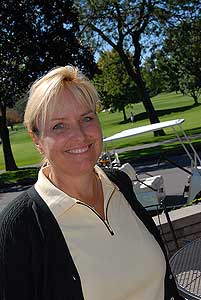 A sweeping renovation occurred in the mid-1990s, according to Clavel. The board members of the club voted to sell many of its sumptuous oil paintings which helped finance a $2 million renovation including a new swimming pool and separate wading pond for toddlers, banquet facilities with sweeping windows, updated kitchen and a large porch for weekend barbecues and al fresco dining. High quality prints of the identical art grace the walls without the high cost of comprehensive security monitors.
A sweeping renovation occurred in the mid-1990s, according to Clavel. The board members of the club voted to sell many of its sumptuous oil paintings which helped finance a $2 million renovation including a new swimming pool and separate wading pond for toddlers, banquet facilities with sweeping windows, updated kitchen and a large porch for weekend barbecues and al fresco dining. High quality prints of the identical art grace the walls without the high cost of comprehensive security monitors.
“We have all kinds of weddings, corporate meetings and just about every kind of special event,” says Danielle Danoit, banquet and catering manager. Outside groups must be sponsored by a member. The revenues help subsidize club activities such as member appreciation night, holiday buffets and the annual President’s Ball.
The challenge of gaining membership in a recessed economy prompted the club to drop its initiation fee from a $35,000 lump sum payment to $19,000 this past spring. Upon acceptance, new members have an optional package of a mini-golf outing for up to eight persons, a pool party for 20 guests or a dinner party in the main dining room for up to eight friends.
Members recruit new members, primarily among golfers with a love of urban spaces.
“My husband, Grady, and I have a standing date for Sunday morning golf,” says Patrice Merritt, executive director of the Friends of the Detroit Library who lives in the Boston-Edison district of Detroit.
“We still love the majestic entrance with a column of trees leading to the front door.” Merritt says. “We love old traditions and an increasingly multicultural membership. Nearly everyone who belongs here is committed to the city’s vitality.”
Maureen McDonald is a frequent contributor to Model D.
Photos:
The Famed 14th hole
The Clubhouse Patio
Men’s Locker Room
The Entrance
Teeing Off
Nancy Clavel Forte
All Photographs Copyright Dave Krieger

